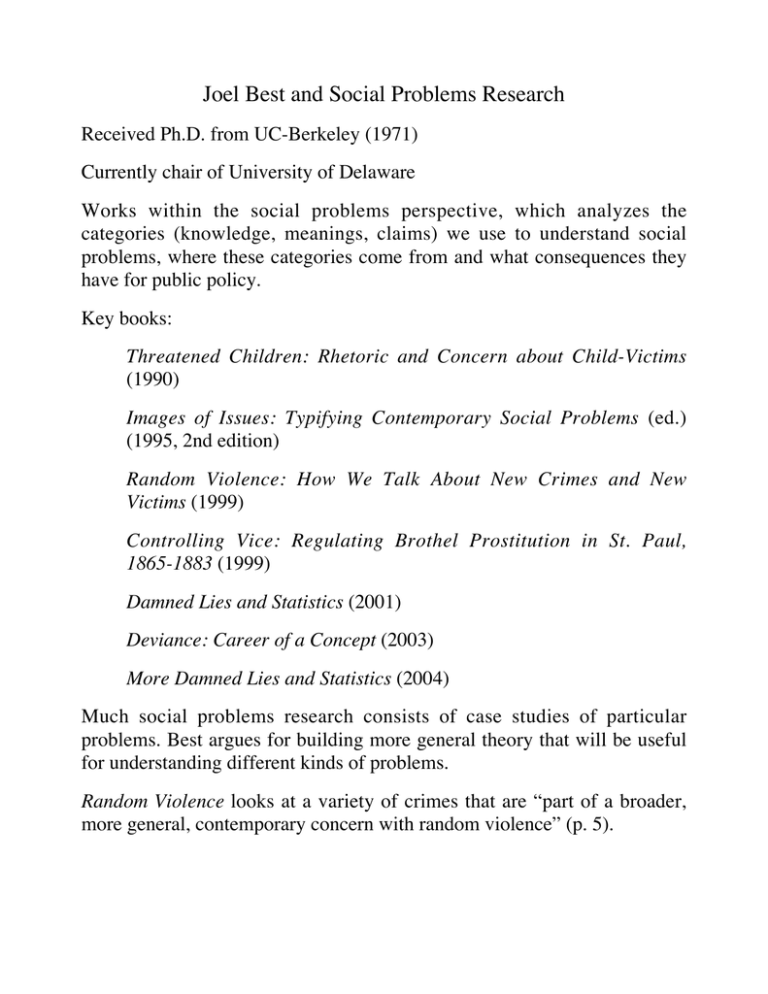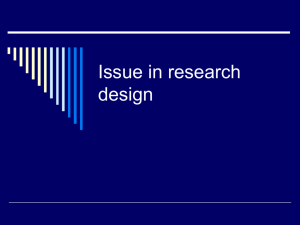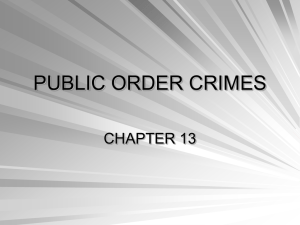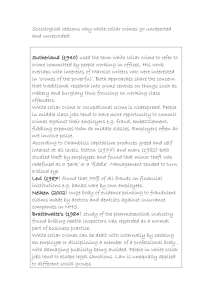Joel Best and Social Problems Research
advertisement

Joel Best and Social Problems Research Received Ph.D. from UC-Berkeley (1971) Currently chair of University of Delaware Works within the social problems perspective, which analyzes the categories (knowledge, meanings, claims) we use to understand social problems, where these categories come from and what consequences they have for public policy. Key books: Threatened Children: Rhetoric and Concern about Child-Victims (1990) Images of Issues: Typifying Contemporary Social Problems (ed.) (1995, 2nd edition) Random Violence: How We Talk About New Crimes and New Victims (1999) Controlling Vice: Regulating Brothel Prostitution in St. Paul, 1865-1883 (1999) Damned Lies and Statistics (2001) Deviance: Career of a Concept (2003) More Damned Lies and Statistics (2004) Much social problems research consists of case studies of particular problems. Best argues for building more general theory that will be useful for understanding different kinds of problems. Random Violence looks at a variety of crimes that are “part of a broader, more general, contemporary concern with random violence” (p. 5). Perspectives on social problems and random crime The objectivist position views social problems as existing in the physical world, not as socially constructed categories. Objectivists study conditions, not meanings. The strict constructionist position focuses only on meanings and doesn’t attempt to judge their accuracy. The contextual constructionist position focuses on meanings, but also claims that we can judge that some meanings better represent the physical world than others. Best is a contextual constructionist. For instance, he argues that crime really isn’t random because: 1. It isn’t patternless. Crimes victimization varies by gender, race and age. 2. It isn’t pointless. Criminals have reasons for committing crimes. 3. It isn’t becoming more common. Crime statistics challenge this view. (In fact, according to the NCVS, property and personal crime are at their lowest rates since the survey began in 1973.) But the rhetoric of random crime is useful to claims-makers because: 1. It evokes powerful imagery and mobilizes maximum social concern. 2. It eliminates the need to explain patterns of crime and allows claims-makers to gloss over awkward topics like class and race. For Best, characterizing crime as random inhibits creating good crime prevention policy. The image of random violence “threatens to shortcircuit constructive thought about the nature of our society’s problems” (p. 26) Some processes involved in constructing social problems Incidents of random crime are turned into instances of larger problems. The media does this by describing, explaining and interpreting crimes. Interpreting involves determining what kind of problem it is. For instance, are freeway shootings a crime problem, traffic problem, gun problem, courtesy problem, medical problem, or media problem? Some problems appear in the media but eventually are no longer news (like wilding or freeway shootings. Other problems get institutionalized. Four social sectors, the “Iron Quadrangle,” are central to institutionalizing problems (like stalking or hate crimes): The media: Necessary to bring attention to problems, but not enough to institutionalize them. Activists: Existing social movements make effective owners of social problems because they have resources (leaders, members, budgets, etc.), ideologies (“interpretive frameworks for making sense of new crimes”) and persistence. Movements also benefit by assuming ownership of new problems Government: Essential for institutionalizing a new crime (by passing a law). Politicians and bureaucrats may support institutionalizing the problem because it gains them additional support, resources and/or press coverage. Experts: May play a key role in institutionalizing crimes because their expertise supports particular interpretations. They benefit from new opportunities for publications, funding, press coverage, etc. The diffusion of new crimes is affected by geography—crimes in Los Angeles, New York or Washington have a better chance of being reported. In constructing new crimes, we draw upon familiar cultural resources, such as the conspiracy, melodramatic imagery, and novelty. New Victims and the Victim Industry One important cultural resource is the ideology of victimization. Between 1960 and 1975 a variety of trends—equal rights movements, focus on victims by the right (crime victims) and left (the underclass), new therapies, etc.—contributed to the rise of a new ideology of victimization. This ideology is based on seven claims: 1. Victimization is widespread 2. Victimization is consequential 3. Victimization is relatively straightforward and unambiguous 4. Victimization often goes unrecognized 5. Individuals must be taught to recognize others’ and their own victimization. 6. Claims of victimization must be respected 7. The term “victim” has undesirable connotations “Taken together, [these claims] form a virtually incontrovertible ideology that encourages identifying and labeling victims… It is, in short, a set of beliefs that makes it easy to label victims, and very difficult to dispute these labels.” (p. 127) Some arrangements that support campaigns of the victim industry 1. Absence of external restraints 2. Extraordinary powers coupled with an absence of internal restraints 3. Structured interests







